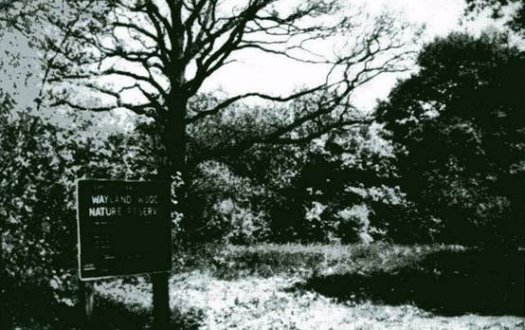
Wayland WoodHis (Robert De Grey) estate was taken over by the Crown and let to racketeers known as Crown Lesses, Two of them, Thomas Felton and John Crotch, leased the wood and engaged a gang of men to fell it. But a friend of Robert de Grey's, Francis Woodhouse of Breckles, heard a whisper of their intentions andwarned Robert so that he could do something it. This he did by paying his fines and bailing himself out. Corning to his nearby Merton estate he collected the employees together and armed with staves and long-handled forks they rushed to Wayland Wood and told Felton and Crotch what would happen to them and their men if the trees were cut down. Discreetly they withdrew. Having known this wood all my life I can remember my father taking me tothe keeper’s cottage when I was about seven and asking the keeper ifhe would show us the tree under which the babes were reputed to have been found, buried by a robin covering them with leaves. He escorted us far in to the wood and stopping by the stump of a large tree, informed us that this was where they died, the tree having been destroyed by lightning in August 1879. As we made our way back to the road I realised how difficult this would have been without our guide, with so many overgrown paths criss crossing each other in all directions. At this time it was not unknown on shooting days for one of the beaters to get lost in the wood during the last "drive" of the day, with darkness falling fast. Occasionally it meant he had to wait until morning light to find his way out. This would not happen today, as one can hear the continuous roar of traffic passing along the road and head towards it. None the less 30 years ago, when "birding" in the wood with a naturalist friend, we came upon an elderly man whom 1 knew very well, but owing to his dishevelled appearance did not recognise at once. He had grown a beard, was painfully thin and obviously so weak he could hardly stand. Although he managed a slight movement of his lips, no sound was forthcoming and we realised he was in a very serious condition. Informing the police, we were surprised to team that he had been missing for three weeks and that they had spent many hours searching for him. As he lived alone, arrangements were made for him to be cared for in a Thetford home and when I saw him a month later he thanked me for saving his life. It appeared that he had strolled far into the wood one afternoon and was unable to find his way out again, but it was not certain if he had been there all the time.
In 1975 Lord Walsingham decided to sell this 85 acres of deciduous woodland to the Norfolk For many centuries the wood was a productive asset and the large hazel stools produced sticks, bean and hop poles and thatchers "broachers". Until recent years the Great Ouse River Authority also used to cut five acres each year for making "fascines", brushwood faggots, used) reclamation work in the marshy fenland areas. Today, the only folk making use of the Hazelwood the local thatchers, the Mindham family of Merton, who for generations have cut their 'broachers" in the wood. Lord Walsingham obtained an assurance from the Norfolk Naturalists Trust that they I allowed to continue before he sold it. Today Wayland Wood contains few oak or ash trees of any considerable age, having contributed its finest timber to the wartime- needs of the country on more than one occasion. Bird cherry beautifies the roadside during May, several tall sallows and maples, a few aspen and some really fir old hollies remain. In their season the wood is carpeted with white anemones, primroses and bluebells. Also large patches of yellow archangel, bugle, water avens, alkanet and various orchids. Botanically however, it is most famous as the only known place in Norfolk where the yellow star < Bethlehem grows, attracting botanists from far and wide. The usual woodland birds are to be four including all three species of British woodpeckers, treecreepers, nuthatch, woodcock, owls, tits, warblers. Some years the rich song of the nightingale was much in evidence, while in others more than two pairs were present. They have declined considerably in recent years and I have not heard one there for a long time. |

